Worldwide Infection Rates and Developments (was Europe only)
#1
Original Poster


Join Date: Nov 2012
Location: Rhineland-Palatinate
Programs: *A Gold (A3), HHonor Gold
Posts: 5,699
Worldwide Infection Rates and Developments (was Europe only)
I would be careful interpreting numbers for several countries now and in the near-mid future, as there are signs the "machine does not work" anymore.
In Belgium the number of test performed is dropping while positivity stays constant. It seems in Europe testing limits has been reached, possibly due to lack of reactants or material (Germany is at 100% capacity, it might be exceeded in France, Czech Republic, Switzerland, UK). Netherlands reports test very late so not sure but it might similar. Additionally the number of cases is high enough that reporting leads to issue, France had some since Sunday and numbers will be corrected later.
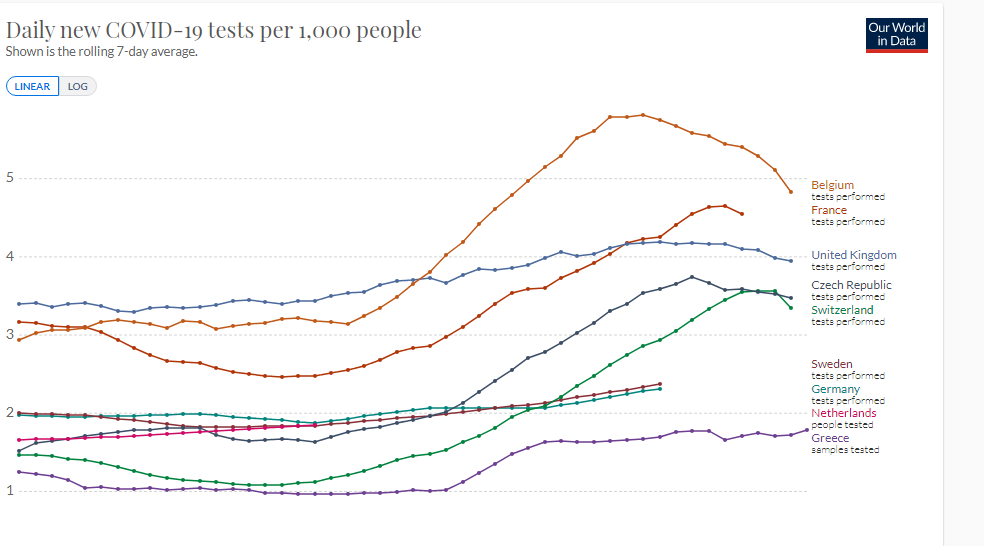
So we might be back to the Spring situation where cases numbers do not mean a lot due to lack of testing and deaths should be the indicator.
In Belgium the number of test performed is dropping while positivity stays constant. It seems in Europe testing limits has been reached, possibly due to lack of reactants or material (Germany is at 100% capacity, it might be exceeded in France, Czech Republic, Switzerland, UK). Netherlands reports test very late so not sure but it might similar. Additionally the number of cases is high enough that reporting leads to issue, France had some since Sunday and numbers will be corrected later.

So we might be back to the Spring situation where cases numbers do not mean a lot due to lack of testing and deaths should be the indicator.
#2
Moderator, Iberia Airlines, Airport Lounges, and Ambassador, British Airways Executive Club
Join Date: Feb 2010
Programs: BA Lifetime Gold; Flying Blue Life Platinum; LH Sen.; Hilton Diamond; Kemal Kebabs Prized Customer
Posts: 63,819
Not so sure about that. In the UK, the amount of capacity unused is also rising for some reason. We don't yet know the full story, positivity is sticking in the 6 to 8% area. Another lab was brought into service last week and it hasn't had many test through it yet. It's going to get a bit confusing soon because there is going to be an attempt over the next week to test everyone in Liverpool with Lateral Flow, those testing positive will be given a second PCR test too, so the figures may start to look very odd.
#3
Original Poster


Join Date: Nov 2012
Location: Rhineland-Palatinate
Programs: *A Gold (A3), HHonor Gold
Posts: 5,699
Here is the Sunday data, hopefully I have got all the Sw* countries lined up this time, though they should be in italics really, neither country updates data at the weekend. Some good news actually, some of the lockdowns are showing some improvements or at least plateaus on the data. The notable exception, France, is very disappointing, at least to this citizen. Hopefully the measures are just taking a bit longer to show improvements, this is a country with no shortage of testing.
Case in point with Belgium, Switzerland: cases are plateauing/decreasing, testing are decreasing, positivity is still clearly upward:


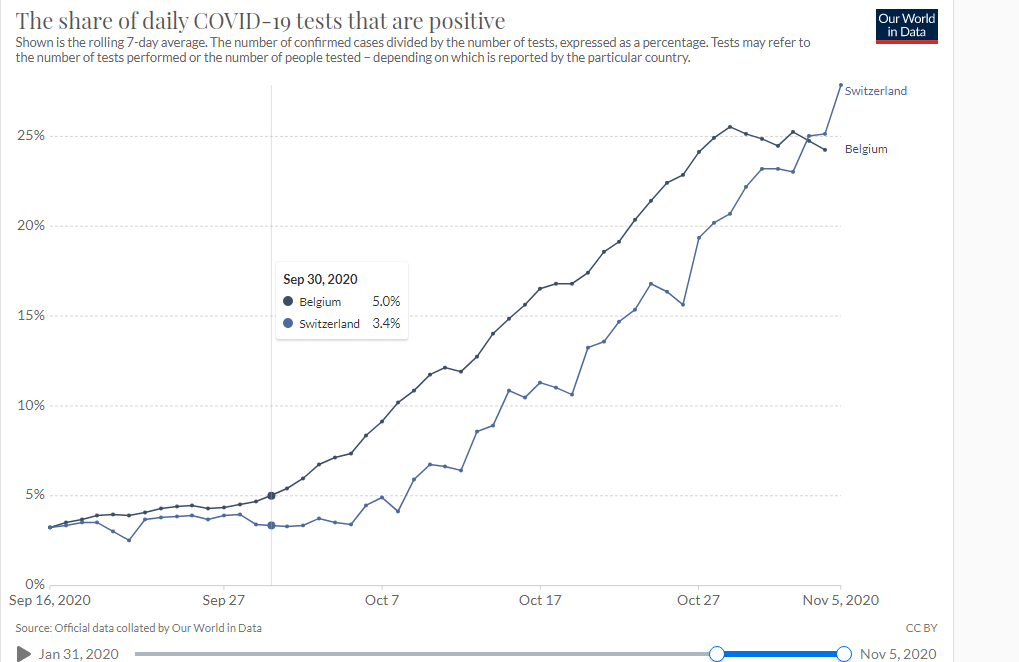
#4
Join Date: Jan 2018
Location: London
Programs: BAEC Gold, Accor Live Limitless Gold, Hilton Honours Gold, Avis Preferred Plus
Posts: 1,807
Thanks once again for your insights and data provision services c-w-s, it certainly is good to see the UK flattening off. I am wondering if there is any guidance as to how the Liverpool testing regime is going to impact these numbers? Will/do these numbers include the results of the LFT tests or just the standard PCR tests or indeed neither? If it is the case that only PCR results are included, I envisage that there could be some oddities going on with people who get reswabbed to do a PCR test after testing positive using the LFT test? (i.e. the daily number [that ends up in the 14 day average] being lower than it could be but for longer)
#5
Moderator, Iberia Airlines, Airport Lounges, and Ambassador, British Airways Executive Club
Join Date: Feb 2010
Programs: BA Lifetime Gold; Flying Blue Life Platinum; LH Sen.; Hilton Diamond; Kemal Kebabs Prized Customer
Posts: 63,819
Thanks once again for your insights and data provision services c-w-s, it certainly is good to see the UK flattening off. I am wondering if there is any guidance as to how the Liverpool testing regime is going to impact these numbers? Will/do these numbers include the results of the LFT tests or just the standard PCR tests or indeed neither? If it is the case that only PCR results are included, I envisage that there could be some oddities going on with people who get reswabbed to do a PCR test after testing positive using the LFT test? (i.e. the daily number [that ends up in the 14 day average] being lower than it could be but for longer)
So yes, it's only PCR figures that show in the UK line in my table, and it's true that the positivity rate will be very high for these tests. UK wide the positivity rate is in the 6% to 8% range, whereas these tests could be 90% plus. However that is balanced against those volunteers who are only getting a PCR test, which is the option open at some of the 17 sites, for those who would rather have an accurate rather than a fast result. Hopefully these won't be particularly positive in comparison. The trial is being done to see if this is effective in taking a whole population out of high infection levels, and thus local restrictions, the statistical implications are, quite rightly, not a factor. It may change the UK chart if - as planned - all major UK cities have this scheme.
#6
FlyerTalk Evangelist, Ambassador, British Airways Executive Club
Join Date: Jun 2008
Location: Somewhere between 0 and 13,000 metres high
Programs: AF/KL Life Plat, BA GGL+GfL, ALL Plat, Hilton Diam, Marriott Gold, blablablah, etc
Posts: 30,536
On the other hand, deaths (coming from other data sources) are rising fast. Of the 1,220 reported yesterday 363 represents a backlog over previous weeks. But the 7-day average is at 550 (Worldometer) and more might be added retroactively. The worst 7-day average in the first wave was 975.
As mentioned earlier, like cws, I'll personally want to wait a few more days to draw any positive conclusions, and am reassured to hear that the Government is finally changing their approach to the (un-cautious) opening of the French "lycees" (colleges for those aged 15-18). That said, the minister's comments are still that figures are starting to go down, especially in the areas which were subject to a curfew before the nationwide lockdown was imposed. The figures in the Paris region, Lyon, or in Marseille have clearly gone down in recent days, including hospital and ICU admissions in those three regions (whilst they are still increasing in several regions that had no curfew like the North East and North West), and the positivity rate has now gone down slowly but consistently nationwide since the peak reached on 3 November. It is still way too high (above 19) but that is a significant decrease on last week.
I think that one thing we learnt for all first lockdowns is there is a significant lag between the time any measure is taken and the time it starts having clear effects; the whole fallacy of things going back to normal after two weeks has long been disproved and once figures are plateauing, there is still doubt as to how long it would take for figures to be down to manageable levels and how long they would likely stay there.
#7
FlyerTalk Evangelist, Ambassador, British Airways Executive Club
Join Date: Jun 2008
Location: Somewhere between 0 and 13,000 metres high
Programs: AF/KL Life Plat, BA GGL+GfL, ALL Plat, Hilton Diam, Marriott Gold, blablablah, etc
Posts: 30,536
Whilst I was initially sceptical, I must now admit it looks like a lot better than merely stabilise. The 7 day figures are now down very sharply on last week, and daily figures are equivalent to UK figures (a bit more two days ago, roughly the same number yesterday, 4000 fewer today, so that mostly cancels out) whilst they frequently reached 50k-60k daily numbers last week. The positivity rate keeps falling and the R estimate is around 0.8. The 14 day figures used by ECDC are slower moving but it is now well below 900 (will show in the morning update) after dangerously flirting with 1000 a few days ago.
The decrease comes a few days later than the Irish, Belgian, and Dutch figures but points to the same basic reality that for better or for worse, at this stage, restrictive measures remain the only confirmed way to significanty reduce the virus circulation.
One question will of course be the effect of those changes on the UK travel policy after the end of the English lockdown. By then, several of those countries will be back to levels below what was deemed acceptable for Germany or Sweden or Denmark a few weeks ago, but somehow, I doubt that it will be a straightforward return to ample 'corridors'.
The decrease comes a few days later than the Irish, Belgian, and Dutch figures but points to the same basic reality that for better or for worse, at this stage, restrictive measures remain the only confirmed way to significanty reduce the virus circulation.
One question will of course be the effect of those changes on the UK travel policy after the end of the English lockdown. By then, several of those countries will be back to levels below what was deemed acceptable for Germany or Sweden or Denmark a few weeks ago, but somehow, I doubt that it will be a straightforward return to ample 'corridors'.
#8
Join Date: Apr 2010
Location: VIE
Programs: SAS EBS / *A Silver, Hilton Diamond, Radisson VIP, IHG Platinum Ambassador
Posts: 3,777
At least at an anecdotal observation it looks like Europe has two sorts of phase 2. Some countries got high levels of infections very quickly, got really high numbers as a result, but then have started to fall quite fast. Whereas other countries seem to have a more gentle increase, a long plateau, and hopefully a fall, but perhaps a quite slow fall.
If Czech and Belgian health care managed to cope (I don't know about BE, but knowing few doctors in CZ it seems they did), then they actually came out of the second wave pretty good and they might be back to relative freedom at the time when the rest of Europe will still struggle (similar thing happened with SE in the spring).
#9
Suspended
Join Date: Jul 2020
Posts: 471
However, I would like to point out we need to be cautious to giving any structural interpretation to the incidence curves over short intervals. We don't just look at cases each day because they fluctuate so wildly for reasons other than the actual virus spread (e.g., reporting delays; overstretched testing regime; idiosyncracies in when people actually go out and get a test). Right, these wild swings is why cws doesn't report new cases or total cases but incidence instead. But if we compare incidence numbers from one day to the next, we're actually going backwards. (The change in incidence is closely related to new cases, so you're losing some of that data smoothing.)
Of course, the numbers can give us some hope that the measures taken may be starting to have an effect. But ultimately, I think we might be well advised waiting for a few more days before giving any kind of structural interpretation to the numbers in BE, DE, CZ, AT, or the UK.
Last edited by flyertalker28120; Nov 15, 2020 at 4:27 am Reason: revised incorrect mathematical description
#10
Original Poster


Join Date: Nov 2012
Location: Rhineland-Palatinate
Programs: *A Gold (A3), HHonor Gold
Posts: 5,699
Exactly, this is what is happening in France right now, there is a very steep decrease. Actually in Ile de France the decrease is 50% in a week, it implies a R of 0.5. During the strictest lockdown the R never got under 0.7, so it can not be an effect of the current lockdown light.
Test number are currently down in Paris:
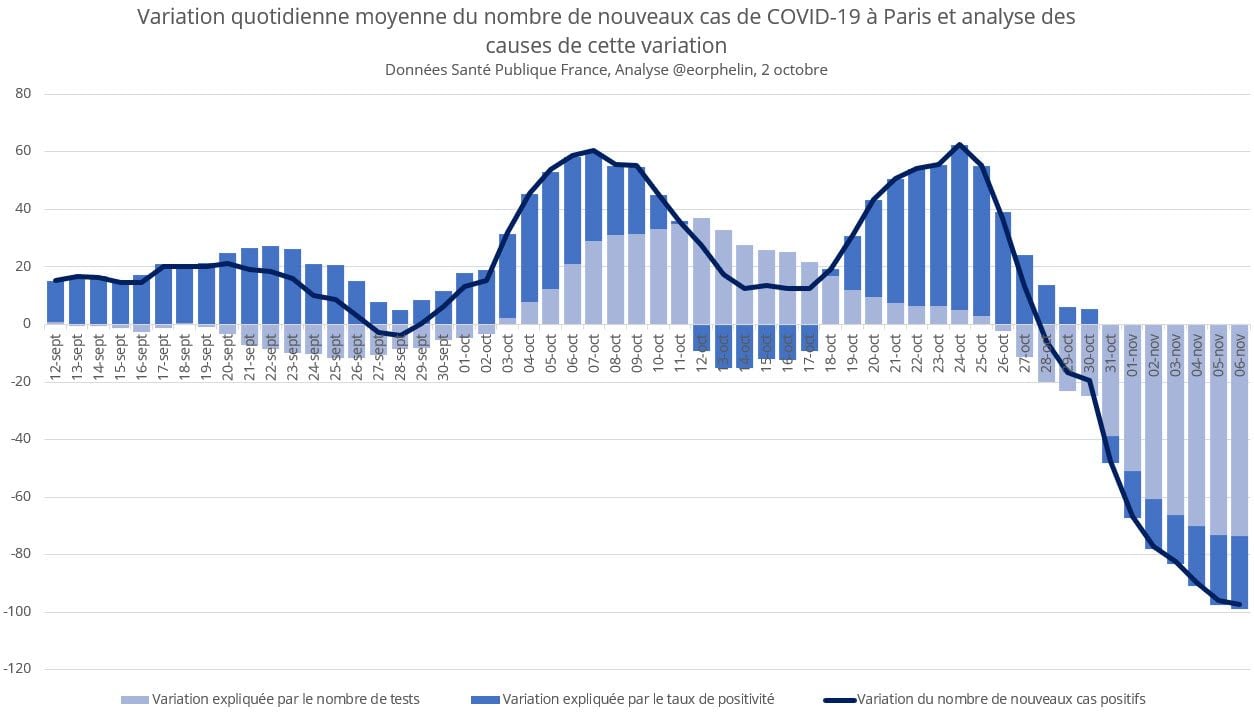
However since a few weeks there is now Rapid Antigenic Testing done in France, but the infrastructure behind is not ready yet. For example the number of RAT done by house doctors, pharmacist, etc... is not being forwarded to the SI-DEP (the database with cases numbers, death, etc ... The ECDC numbers used by CWS are coming from SI-DEP). The infrastructure for them to forward tests will be ready, well today as it were.
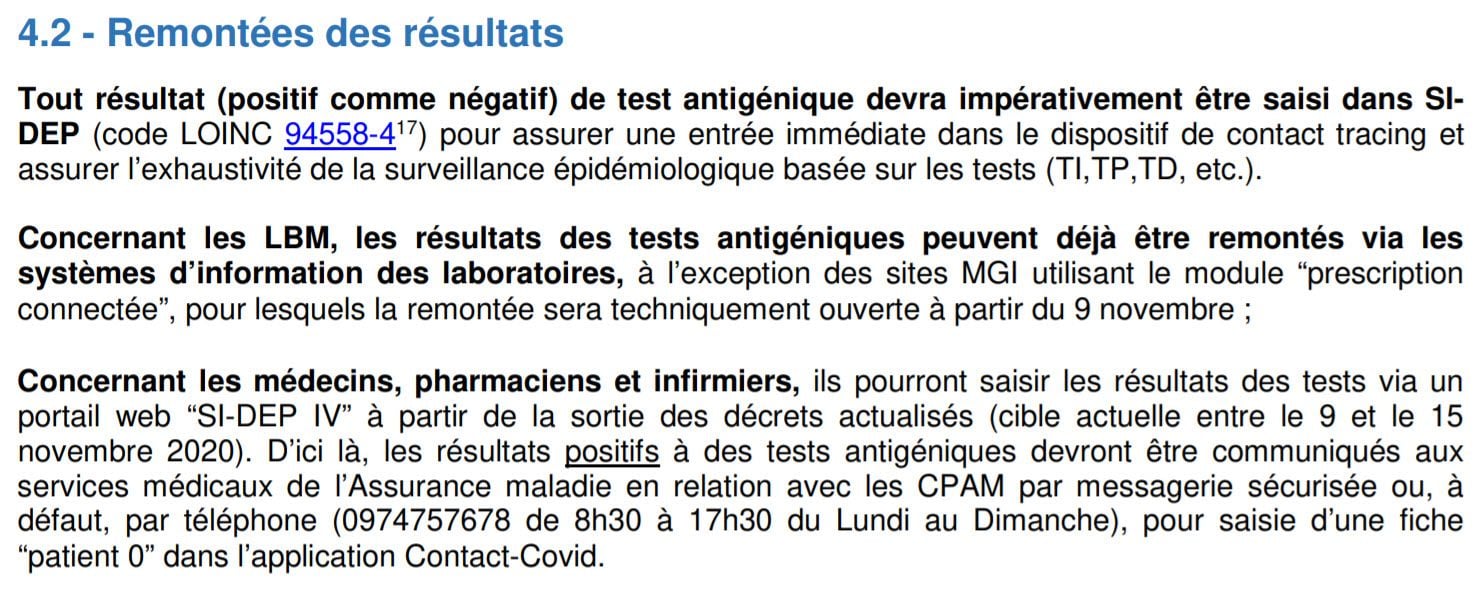
So all the cases those tests are finding are not counted in the table from CWS.
And we know the number of cases found by those tests are increasing, because Sante Publique France has the numbers:
Week 43 : 107 cases
Week 44 : 2 534 cases
Week 45 : 8 691 cases
If the ratio of people tested with RAT increases, then the more the incidence is under-evaluated.
This is not a certainty but a possibility to explain with data this strong decrease that nobody currently explain.
Same in Belgium or Czech Republic, the decrease is not fully explained.
https://www.rtbf.be/info/societe/det...ue?id=10629813
There are various thesis which are being thrown around, one of them very interesting but which I would not detail here. The next two weeks should help us to see if this decreases is more due to the "virus" or more due to the test regimen changing.
Test number are currently down in Paris:

However since a few weeks there is now Rapid Antigenic Testing done in France, but the infrastructure behind is not ready yet. For example the number of RAT done by house doctors, pharmacist, etc... is not being forwarded to the SI-DEP (the database with cases numbers, death, etc ... The ECDC numbers used by CWS are coming from SI-DEP). The infrastructure for them to forward tests will be ready, well today as it were.

So all the cases those tests are finding are not counted in the table from CWS.
And we know the number of cases found by those tests are increasing, because Sante Publique France has the numbers:
Week 43 : 107 cases
Week 44 : 2 534 cases
Week 45 : 8 691 cases
If the ratio of people tested with RAT increases, then the more the incidence is under-evaluated.
This is not a certainty but a possibility to explain with data this strong decrease that nobody currently explain.
Same in Belgium or Czech Republic, the decrease is not fully explained.
https://www.rtbf.be/info/societe/det...ue?id=10629813
There are various thesis which are being thrown around, one of them very interesting but which I would not detail here. The next two weeks should help us to see if this decreases is more due to the "virus" or more due to the test regimen changing.
#11
FlyerTalk Evangelist, Ambassador, British Airways Executive Club
Join Date: Jun 2008
Location: Somewhere between 0 and 13,000 metres high
Programs: AF/KL Life Plat, BA GGL+GfL, ALL Plat, Hilton Diam, Marriott Gold, blablablah, etc
Posts: 30,536
In other words, the impact of face to face teaching is not only people being infected in the classroom (very few) but people being infected in the entire university ecosystem - both on and off campus - which would not be functioning without keeping high levels of face to face teaching.
It's actually a directly parallel question to that of travel wich is at the heart of quarantine and testing systems. There are extremely few people infected whilst they are on a plane, and it was not even necessarily a case of infections being higher abroad than in the countries implementing restrictions, but infections did occur when travellers were visiting family, patronising clubs and bars or more generally being dishinibited and less careful than (some) would be at home. This is a reason why many European countries found that visitors were in fact significantly more likely to be covid infected than local populations, effectively due to more risky behaviour and the entire ecosystem of travel rather than travel itself.
In the meantime, with today's infections figure of nearly 25,000 cases, the UK two weeks incidence figure will sadly break the symbolic 500 threshold for the first time. This is not a big increase for the 14 day figures (though it is not insignificant for the 7 day figure as last week seemed to show a reduction in infection numbers), but it is a bit worrying that figures are not going down yet whilst they are elsewhere (and notwithstanding the points rightly made by others about why to take the magnitude of downturn figures with a pinch of salt as lockdowns invariably result in a reduction in testing, the downtrend is a clear one in those countries as evidenced by meaningful and continuous reduction in both the R rate and the positivity rate).
Last edited by orbitmic; Nov 15, 2020 at 9:28 am
#12
FlyerTalk Evangelist
Join Date: Nov 2003
Location: Wesley Chapel, FL
Programs: American Airlines
Posts: 30,023
#13
Ambassador, British Airways; FlyerTalk Posting Legend
Join Date: Apr 2012
Location: Leeds, UK
Programs: BA GGL/CCR, GfL, HH Diamond
Posts: 42,968
An argument was the hospital occupancy for covid cases was rapidly rising again, and if action was not taken it would have risen above what we experienced earlier this year. This graph is for England only.
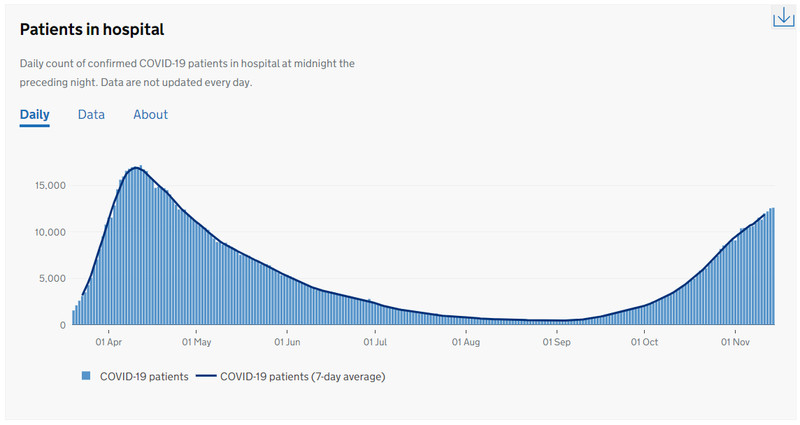
https://coronavirus.data.gov.uk/deta...eaName=England

https://coronavirus.data.gov.uk/deta...eaName=England
#14
Join Date: Mar 2007
Location: Berlin
Posts: 1,765
Seems we have at least an intermediate peak around 20k cases per day here in Germany. The reporting quirks makes it hard to tell until midweek. After a week or so of trending downwards, R value has gone back over 1. ICU use is at a record high here in Berlin at 22% for COVID patients. At 8% positivity rate, doesn't seem to be really much good news in the data. We can only hope this is a plateau.
#15
Join Date: Jan 2009
Location: London, Sth Africa or LAS
Programs: VS Silver, BA Blue - finally; but hotels.com Gold :)
Posts: 1,858
However since a few weeks there is now Rapid Antigenic Testing done in France, ......
So all the cases those tests are finding are not counted in the table from CWS.
And we know the number of cases found by those tests are increasing, because Sante Publique France has the numbers:
Week 43 : 107 cases
Week 44 : 2 534 cases
Week 45 : 8 691 cases
If the ratio of people tested with RAT increases, then the more the incidence is under-evaluated.
This is not a certainty but a possibility to explain with data this strong decrease that nobody currently explain.
So all the cases those tests are finding are not counted in the table from CWS.
And we know the number of cases found by those tests are increasing, because Sante Publique France has the numbers:
Week 43 : 107 cases
Week 44 : 2 534 cases
Week 45 : 8 691 cases
If the ratio of people tested with RAT increases, then the more the incidence is under-evaluated.
This is not a certainty but a possibility to explain with data this strong decrease that nobody currently explain.
Once again this reminds us that the data ECDC and C-W-S draw on, is confirmed positive tests (of a certain source). All fine.
However, those reported confirmed positive tests only cover a proportion of the actual infected people in a particular population. Many asymptomatics won't know and go for a test, for example; similarly not all symptomatics will go get tested.
So the countries' and ECDC data is always understated if looking to infer total infections in the population. Fine again, so long as this point is not forgotten.
The French example currently working through and discussed by fransknorge is yet another case in point. Trying to work out what is going on at the French population level needs extra nuancing currently.
I wouldn't be surprised if similar will play out elsewhere; eg UK & Liverpool potentially.
These newer (and faster) tests are a fantastic development. They will, however, likely change the data gathering and reporting landscape significantly.
Meanwhile, any updates on the Slovakian mass testing? That would seem to fit in this new thread?




















